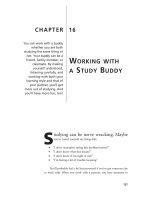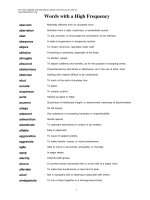Dealing with a digital crisis
Bạn đang xem bản rút gọn của tài liệu. Xem và tải ngay bản đầy đủ của tài liệu tại đây (11.83 MB, 36 trang )
Dealing
with a
digital
crisis.
European Chamber of
Commerce,
Taipei
November 03, 2010
Burson-Marsteller l Asia-Pacific l Evidence-Based Communications
What we’re going to cover today
What’s driving issues and crisis today
Crisis communications approach and framework
How to manage issues before they escalate
How to respond during a crisis
Recovering from a crisis
Burson-Marsteller l Asia-Pacific l Evidence-Based Communications
Companies feel vulnerable
Q: Which, if any, of the below are reasons why you feel it is more difficult to plan for a crisis today?
(Among those who feel it is more difficult to plan)
Source: Digital Crisis Preparation Study – Burson-Marsteller/Penn Schoen Berland, August 2011
Burson-Marsteller l Asia-Pacific l Evidence-Based Communications
Digital seen as an ever bigger threat
Q: How likely do you think it is that your company will experience any of the following potential crisis
in the next 6-12 months? (Top 2 Very + Somewhat likely to experience this type of crisis)
Global
Controversial company developments
50%
Online or digital security failure
47%
Logistic difficulties
47%
Intense regulatory scrutiny of your product or company
45%
Critical or negative new media campaigns
43%
Danger to product safety
42%
Technical accidents
40%
Intense political scrutiny of your product or company
40%
Criminal actions
33%
Source: Digital Crisis Preparation Study – Burson-Marsteller/Penn Schoen Berland, August 2011
Burson-Marsteller l Asia-Pacific l Evidence-Based Communications
Product safety the top concern in Asia
Q29-37: How likely do you think it is that your company will experience each of the following in
the next 6-12 months? (Top 2 Very + Somewhat likely to experience this type of crisis)
Burson-Marsteller l Asia-Pacific l Evidence-Based Communications
US
EU
APAC
LATAM
GLOBAL
US
EU
54%
LATAM
APAC
GLOBAL
53%
Issues & crisis triggers
Product quality
Health & safety
Lay-offs/closures
Data loss
Supply chain management
Whistleblowers
Environment
Human rights
Equal employment
Customer service
Disgruntled employees
Nationalism
Greenwashing
Monopolisation
Marketing
Burson-Marsteller l Asia-Pacific l Evidence-Based Communications
Supply chain management
Burson-Marsteller l Asia-Pacific l Evidence-Based Communications
Customer service
Burson-Marsteller l Asia-Pacific l Evidence-Based Communications
Whistleblowers
Burson-Marsteller l Asia-Pacific l Evidence-Based Communications
Disgruntled employees
Burson-Marsteller l Asia-Pacific l Evidence-Based Communications
Marketing
Burson-Marsteller l Asia-Pacific l Evidence-Based Communications
The role of the Internet
ESCALATES
DISTRIBUTES
Truth, half truth, untruth
Burson-Marsteller l Asia-Pacific l Evidence-Based Communications
A crisis is not a ‘crisis’ until…
Burson-Marsteller l Asia-Pacific l Evidence-Based Communications
Crisis framework
Prepare
Recover
Respond
Reassure
Burson-Marsteller l Asia-Pacific l Evidence-Based Communications
Crisis preparedness – social media policy
Burson-Marsteller l Asia-Pacific l Evidence-Based Communications
Crisis preparedness – community guidelines
Burson-Marsteller l Asia-Pacific l Evidence-Based Communications
Crisis preparedness – social media listening
Burson-Marsteller l Asia-Pacific l Evidence-Based Communications
Crisis plan & checklist
Crisis leader, core team & alternates
Crisis team roles & responsibilities
Spokespeople
Approval processes
Stakeholder & influencer lists
Communications channels
Monitoring tools (online & offline)
Communications templates
– FAQ, holding statement, press release etc
List of external advisors & suppliers
Burson-Marsteller l Asia-Pacific l Evidence-Based Communications
Crisis framework
Prepare
Recover
Respond
Reassure
Burson-Marsteller l Asia-Pacific l Evidence-Based Communications
Communications mix
PAID
EARNED
Reach
OWNED
+
Control
Burson-Marsteller l Asia-Pacific l Evidence-Based Communications
-
10 online crisis communications principles
#1
#2
#3
#4
#5
#6
#7
#8
#9
#10
Listen continuously
Move fast
Be accurate
Be patient
Be transparent
Be consistent
Be responsive
Be human
Be sincere
Don’t be heavy-handed.
Burson-Marsteller l Asia-Pacific l Evidence-Based Communications
#1 Listen continuously
Burson-Marsteller l Asia-Pacific l Evidence-Based Communications
#2 Move fast
• 10.38am: A consumer went to Drugstore X to purchase nutritional product and was told they
had been recalled and they had no stock at the moment
• 11.46am: Rumor up in online that a hero nutritional products had just been recalled in a
leading drugstore (Drugstore X) in Hong Kong
• 12.56pm: Apple Daily caught the rumor online and called ABC company to clarify
• 1.15pm: Internal assessment and confirmed there was no such recall. It was just a rumour
• 1.30pm: Confirmed with Drugstore X that it was misunderstanding among the Drugstore staff
• 1.50pm: Take immediate action to liaise with the website with a clarification note posting
online to cease the rumor spreading
• 2.15pm: Alert immediately the retail chains and aligned them with the agreed media
messages
• 2.30pm: Prepare Customer Relations Representatives (hotlines) with agreed key messages
that align with media statement
• 3.00pm: Negotiate with retail outlets on stock availability
• 3.30-4.30pm: Reply to in-coming media enquiries online and in print
Burson-Marsteller l Asia-Pacific l Evidence-Based Communications
#3 Be accurate
Burson-Marsteller l Asia-Pacific l Evidence-Based Communications
#4 Be patient
Burson-Marsteller l Asia-Pacific l Evidence-Based Communications









